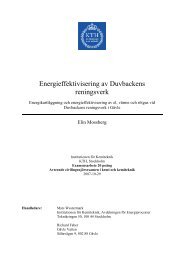Problematik vid höga flöden - Gästrike Vatten AB
Problematik vid höga flöden - Gästrike Vatten AB
Problematik vid höga flöden - Gästrike Vatten AB
You also want an ePaper? Increase the reach of your titles
YUMPU automatically turns print PDFs into web optimized ePapers that Google loves.
efficiency can be achieved by withdrawing the excess of sludge formed, containing the<br />
biomass of PAO whith high phosphorus content within its cells.<br />
Sweden and other northen countries have experienced an increased level of precipitation<br />
during the last decades and both the level and intensity of these events can, according to<br />
present climate models, be expected to increase further during the decades to come. This has<br />
an impact on the wastewater treatment systems of the communities which receives a higher<br />
level of stormwater both to the sewers and to the wastewater treatment plants (WWTP). This<br />
occurs due to drainage from houses and leakage into the pipe-system. Another reason for high<br />
influx flows can be that storm drains are not always operated independently from sanitary<br />
sewer systems, especially in older parts of the cities, where the pipe-system can be more than<br />
a hundred years old. Apart from the risk of discharging untreated sewage into the<br />
environment, the increased flow can also lead to serious failures at the WWTP, especially<br />
when biological treatment methods are being applied.<br />
An activated sludge system with EBPR is very sensitive to external disturbances, such as high<br />
influx flows. This can either deteriorate the phosphorus removal efficiency instantaneously or,<br />
if the disturbance is prolonged, cause the ecosystem of the activated sludge to shift in favour<br />
of other microorganism types than the essential PAO. The latter can affect the ability to<br />
remove phosphorus biologically for long periods, in the order of weeks to months, until the<br />
microbial population of PAO is re-established in the system. The weakened overall system<br />
performance can also render the need for chemical precipitation of phosphate. This can have a<br />
further inhibiting effect on the recovery of the EBPR process, since the biologically available<br />
phosphate becomes chemically bound and therefore limits the ability to rebuild the<br />
endogenous poly-P pools (Tykesson et al., 2003).<br />
One of the most crucial factors related to high influx flows is the availability of easily<br />
biodegradable substrates in the influent wastewater feeding the PAO in the anaerobic stage of<br />
the process. A correlation has been found between the VFA-feed and the phosphate release in<br />
the anaerobic reactor and hence the overall phosphorus removal performance (Carlsson et al.,<br />
1996, Lie et al., 1997). During high-flow conditions the WWTP temporary receives a diluted<br />
sewage at a high hydraulic load. The concentration of VFA has been shown to decrease and,<br />
at the same time, the VFA to phosphate ratio is reduced during these conditions (Carlsson et<br />
al., 1996). Depending on the duration of the highflow, this may result in a partial or complete<br />
depletion of the endogenous carbon reserves, and leads to high effluent phosphate loadings<br />
(Temmink et al., 1996). During these conditions microbial growth becomes substrate limited,<br />
and the PAO tend to focus on maintenance using utilized energy for survival processes and<br />
excluding the uptake of phosphate. If the conditions are prolonged the active biomass of PAO<br />
can be reduced (Lopez et al., 2006).<br />
When the conditions have been normalized after a high-flow event the effluent phosphorus<br />
concentration has been reported to peak (Pitman et al., 1983). This is due to a temporary<br />
imbalance between phosphate-release and uptake. The phosphate release is recovered almost<br />
instantly while the phosphate uptake depends on a slowly rising level of PHA in the cell, and<br />
is therefore delayed (Temmink et al., 1996, Miyake et al., 2005).<br />
The WWTP Duvbacken in Gävle was rebuilt for EBPR during 2004. During the first years the<br />
phosphorus removal capacity was unstable. The main reason to this was found to be a lack of<br />
organic substrate for the process. A sufficient level of VFA was achieved by introducing a<br />
main stream primary sludge hydrolysis in 2007. This was achieved by pumping sludge from<br />
54






